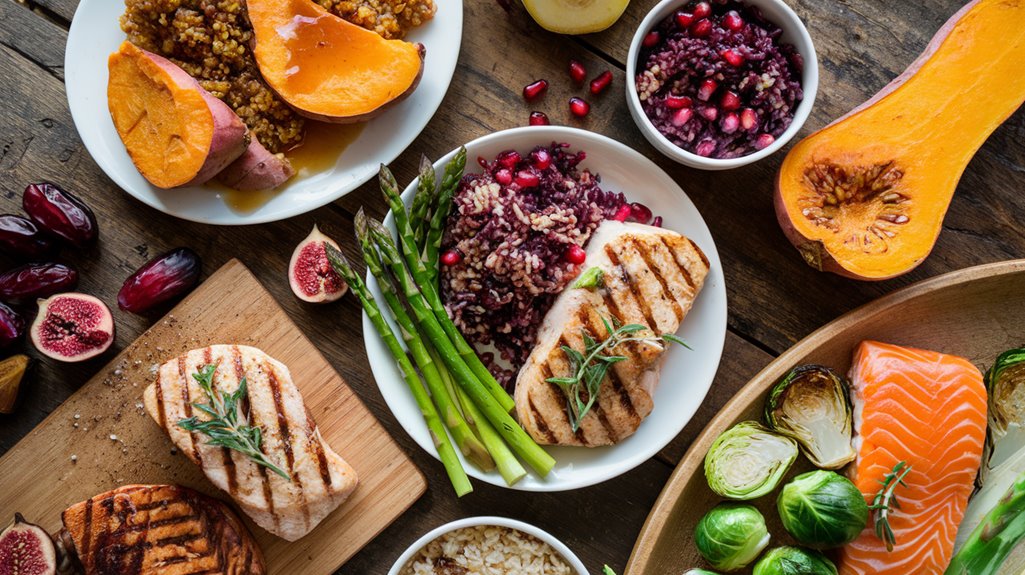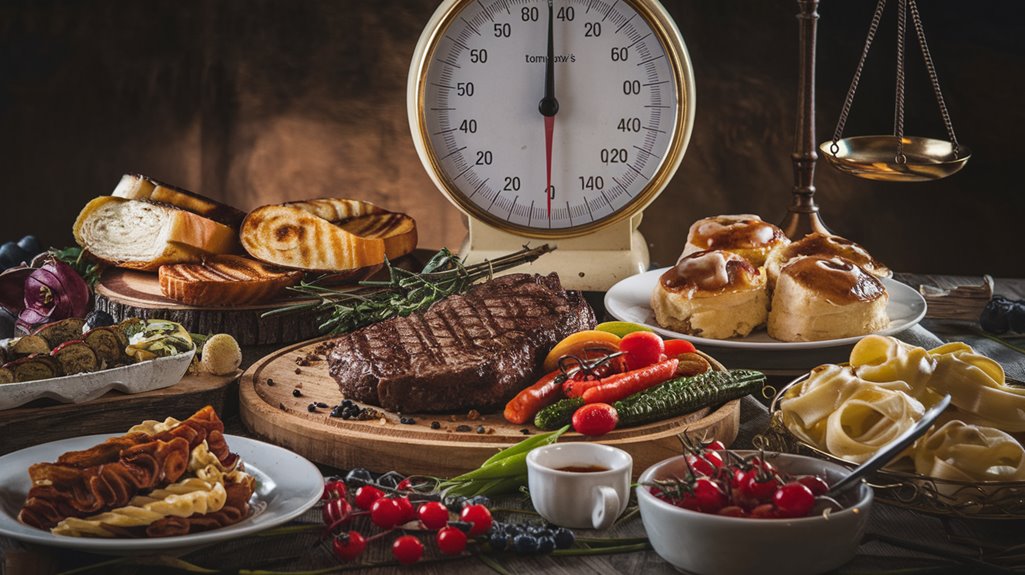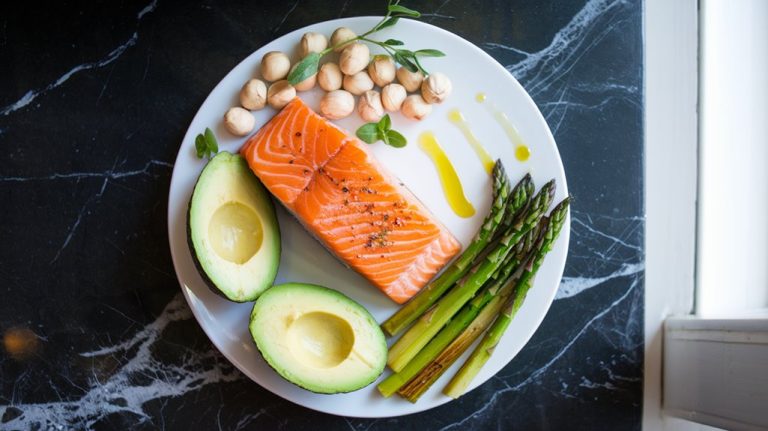You can optimize your ketogenic lifestyle by following a strategic feast-fast protocol that enhances metabolic flexibility. On feast days, consume 100-150g of complex carbohydrates within an 8-10 hour window, paired with adequate protein and healthy fats. Follow this with a 16-24 hour fasting period to quickly return to ketosis. Monitor your blood glucose and ketone levels to guarantee proper adaptation. Understanding the science behind this approach will help you maximize its benefits.
Keto Highlights
- Structure feast meals within an 8-10 hour window, consuming 100-150g complex carbohydrates from whole food sources like quinoa and sweet potatoes.
- Follow feast day with a fasting period of 16-24 hours, consuming only water, black coffee, or unsweetened tea.
- Break the fast with bone broth, then gradually introduce proteins and complex carbohydrates while limiting daily carbs to 50-100g.
- Monitor blood glucose levels post-feast, aiming to return to fasting levels below 100 mg/dL within 48 hours.
- Increase dietary fat to 70-80% of calories after breaking the fast to accelerate ketone production and restore ketosis.
Understanding Metabolic Flexibility on Keto
When following a ketogenic diet, understanding metabolic flexibility becomes essential for enhancing your body's ability to efficiently use different fuel sources. Your metabolism's capacity to switch between burning carbohydrates and fats directly impacts your success on keto.
You'll experience enhanced fat-burning capabilities and stable energy levels as your body becomes more metabolically flexible. This adaptation is closely tied to improved insulin sensitivity and cognitive function due to efficient ketone utilization. Key factors influencing your metabolic flexibility include your insulin response, physical activity level, sleep quality, and stress management.
Research shows that metabolic flexibility isn't just about diet – it's your body's natural state for peak health. By maintaining this metabolic advantage, you're better equipped to handle occasional carbohydrate intake while still preserving the benefits of ketosis.
The Science Behind Feast Days and Ketosis
Understanding feast days in a ketogenic lifestyle requires examining their complex physiological effects on metabolic pathways. When you introduce carbohydrates during a feast day, your body temporarily exits ketosis while triggering several beneficial metabolic responses, including improved insulin sensitivity and increased leptin production.
Your body's response to feast days includes:
- Enhanced thyroid hormone production, supporting overall metabolic function
- Replenishment of glycogen stores, potentially improving exercise performance
- Increased leptin levels, which can boost metabolism and regulate appetite
You'll typically return to ketosis within 24-48 hours after a feast day, provided you limit the duration to 24 hours and don't exceed your caloric needs by more than 20-30%. Focus on nutrient-dense carbohydrates and maintain adequate protein intake to maximize the benefits while minimizing potential risks.
Benefits of Strategic Carb Loading
Strategic carb loading can enhance your athletic performance by increasing muscle glycogen stores up to 50% while supporting essential protein synthesis for recovery. You'll notice improved endurance capabilities, with potential performance gains of 2-3% and sustained energy levels during activities lasting over 90 minutes. The increased carbohydrate intake temporarily boosts your resting metabolic rate and helps maintain ideal hormone levels, particularly insulin and leptin, which can become depleted during extended periods of carb restriction.
Performance and Muscle Recovery
Through decades of sports nutrition research, carbohydrate loading has emerged as a powerful strategy for maximizing athletic performance and muscle recovery. By increasing muscle glycogen stores up to 100%, you'll experience enhanced endurance and a 2-3% boost in performance during long events. Strategic carb intake creates an ideal anabolic environment, stimulating insulin release that drives nutrients into muscle cells.
- Consume 10-12g of carbs per kg bodyweight 36-48 hours before major events
- Replenish glycogen stores post-workout with high-GI foods and ≥8g/kg/day carb intake
- Maintain adequate carb levels to reduce muscle damage and accelerate recovery
This protocol not only fuels your workouts but also supports protein synthesis, reduces muscle soreness, and prepares your body for subsequent training sessions, creating a sustainable cycle of performance and recovery.
Metabolic Rate Boost
When implemented correctly, strategic carb loading can dramatically boost your metabolic rate through multiple physiological pathways. Your body responds to carb refeeds by increasing leptin production by 28-50% within 24 hours, which directly enhances thyroid function and energy expenditure.
You'll experience improved metabolic flexibility as your body becomes more efficient at switching between fat and carbohydrate metabolism. This enhanced metabolic state allows you to burn fat more effectively during low-carb periods while optimizing glucose utilization during high-carb phases. The cyclical approach also prevents the metabolic slowdown often associated with prolonged low-carb dieting.
Your insulin sensitivity improves with strategic carb loading, leading to better nutrient partitioning and increased glycogen storage in muscles. This metabolic advantage supports both fat loss and muscle preservation efforts.
Planning Your Feast Day Menu
Successfully planning your feast day menu requires careful consideration of meal timing, macronutrient targets, and overall caloric needs. You'll want to structure your eating within an 8-10 hour window, spacing 2-3 substantial meals 4-6 hours apart for ideal digestion and nutrient absorption.
- Target your macronutrients precisely: 100-150g of complex carbohydrates, 1.2-1.6g protein per kg body weight, and 50-60% of calories from healthy fats
- Calculate your feast day calories based on gender: women typically need 1800-2200 calories, while men require 2400-3000 calories
- Support your feast day with proper hydration: consume 2-3 liters of water, increase electrolyte intake, and incorporate probiotic-rich foods for digestive health
Fine-tune these parameters based on your activity level and specific body composition goals.
Optimal Food Choices for Higher Carb Days

When increasing your carbohydrate intake during higher carb days, you'll want to prioritize complex carbohydrates from whole food sources like quinoa, sweet potatoes, and legumes rather than processed options. Strategic portion control helps maximize the benefits while preventing overconsumption, so measure your servings and track your total daily intake. You can enhance the nutritional value of your meals by pairing quality carbs with lean proteins and fiber-rich vegetables, which helps stabilize blood sugar and promote satiety.
Quality Carbs Over Quantity
Rather than focusing solely on carbohydrate amounts, selecting high-quality carb sources can maximize the benefits of your higher carb days while minimizing potential drawbacks. You'll want to emphasize complex carbohydrates that provide sustained energy and additional nutritional benefits, such as fiber, vitamins, and minerals.
- Choose nutrient-dense whole grains like quinoa, brown rice, and farro, which offer both complex carbs and protein to help stabilize blood sugar levels
- Include fibrous fruits and vegetables, particularly berries and leafy greens, as they're rich in antioxidants and provide sustained energy
- Pair your carbs with protein sources like Greek yogurt or legumes to slow digestion and enhance nutrient absorption
Remember to time your carb intake around your workouts and distribute them throughout the day for maximum energy utilization.
Smart Portion Control Strategies
Managing portion sizes effectively on higher carb days requires a strategic combination of measurement techniques and food selection to maintain metabolic flexibility while preventing overconsumption. You'll want to employ precise measurement tools like kitchen scales for accurate portions of nutrient-dense carbs such as sweet potatoes, quinoa, and legumes.
Use the hand method as a portable portion guide: your cupped hand represents your carb serving, while your palm indicates protein portions. Pre-portion your meals into containers, focusing on earlier consumption when insulin sensitivity is ideal. Pair your carbs with protein and healthy fats to stabilize blood sugar and enhance satiety. Choose smaller plates to create a visual illusion of larger portions, and practice mindful eating by chewing slowly to better recognize fullness signals.
Breaking Down the Fast Protocol
To maximize the benefits of your ketogenic fast, understanding the protocol's four key phases is essential. You'll start by preparing your body the evening before, ensuring you've consumed your last meal by 8 PM and stayed properly hydrated. During the fasting window, you're limited to zero-calorie beverages and specific supplements to maintain electrolyte balance.
- Consume only water, black coffee, or unsweetened herbal tea
- Supplement with sodium, potassium, and magnesium as needed
- Include bone broth (<50 calories) if necessary for longer fasts
When breaking your fast, start small to prevent digestive issues. Begin with bone broth, then gradually introduce easily digestible proteins and complex carbohydrates. Wait 1-2 hours before consuming a full meal, and avoid high-fat foods initially to prevent gastrointestinal discomfort.
Maximizing Fat Adaptation Post-Feast

After indulging in a feast day, your body requires specific protocols to efficiently return to ketosis and maximize fat adaptation. You'll need to strategically reintroduce carbohydrates over 24-48 hours, consuming 30-60g within the first two hours post-feast for ideal glycogen replenishment. Then, limit daily carb intake to 50-100g for the next 2-3 days.
To accelerate ketone production, increase your dietary fat to 70-80% of total calories and supplement with 1-2 tablespoons of MCT oil daily. Incorporate HIIT workouts within 12-24 hours post-feast, followed by resistance training to enhance muscle glycogen uptake. Monitor your blood glucose levels, aiming for fasting levels below 100 mg/dL within 48 hours, and track ketones until you reach 0.5-3.0 mmol/L within 72 hours.
Monitoring Your Body's Response
Successful implementation of a ketocycles cheat meal protocol depends on systematic monitoring of multiple biomarkers. Track your blood ketones and glucose levels before and after feast meals to understand your metabolic response. Use a blood ketone meter for accuracy, aiming to maintain levels between 0.5-3.0 mmol/L during regular ketosis phases.
Track ketone and glucose levels diligently to optimize your ketocycles protocol, using precise measurements to maintain optimal metabolic function.
- Monitor body composition changes using bioelectrical impedance scales and waist measurements to track fat loss progress
- Record physical performance metrics, including strength levels and workout recovery times
- Track energy levels on a 1-10 scale throughout the day, particularly noting changes post-feast
Combine these data points to assess how your body handles the feast-fast cycle. Adjust your protocol based on these measurements, ensuring you're maintaining metabolic flexibility while progressing toward your goals.
Common Pitfalls and How to Avoid Them

Your mindset during a carb-loading phase can make the difference between a controlled refeed and a destructive binge cycle that disrupts ketosis for days. To maintain metabolic stability, you'll need to view carb consumption as a strategic tool rather than a reward or escape from your nutrition plan. You can prevent post-feast derailment by planning your portions in advance, selecting high-quality carbohydrate sources, and immediately returning to your ketogenic protocol at the next meal.
Mindset During Carb Loading
Maintaining psychological balance during carb loading phases presents unique challenges for ketogenic dieters. You'll need to cultivate a growth mindset and understand that temporary carb increases won't derail your progress. Practice mindfulness and self-awareness to avoid common mental traps like all-or-nothing thinking or guilt about increased carb intake.
- Keep a detailed food journal tracking both intake and emotions to identify patterns and maintain accountability
- Set clear, realistic expectations for the carb loading period and visualize positive outcomes
- Develop specific coping strategies for managing cravings and emotional eating triggers
Focus on nutrient-dense carb sources and remember that this is a strategic protocol, not a free-for-all. Working with an accountability partner or coach can provide valuable support and help maintain perspective during the carb loading phase.
Preventing Post-Feast Derailment
While shifting back from a carb-loading feast presents significant metabolic and psychological hurdles, understanding common pitfalls can help prevent post-feast derailment. You'll face temporary insulin spikes, water retention, and reduced ketone production for up to 48 hours. To minimize these effects, don't extend your cheat meal into multiple days, as this can trigger addictive eating patterns and prolonged metabolic disruption.
Plan your post-feast recovery carefully by tracking macros strictly, managing potential digestive issues like bloating and GI discomfort, and maintaining precise meal prep routines. Combat negative self-talk and guilt by remembering that temporary metabolic changes are normal. Stay focused on your established keto protocols despite social pressure to continue indulging, and monitor your body's response to optimize future carb-loading sessions.
Tips for Maintaining Long-Term Success
Long-term success on the Ketocycles protocol requires a thorough approach that extends beyond just following meal plans. You'll need to integrate consistent habits that support your metabolic flexibility and maintain ketosis between feast days.
Success with Ketocycles demands more than meal planning – it requires building sustainable habits that support metabolic adaptation and ketosis maintenance.
- Establish a structured meal prep routine that includes batch cooking keto-friendly meals and keeping portable snacks ready for unexpected situations.
- Combine regular exercise with strategic timing – aim for 150 minutes of moderate activity weekly, including both cardio and strength training, while adjusting intensity during fasting periods.
- Practice mindful eating techniques by using smaller plates, eating without distractions, and measuring portions to maintain accurate macro tracking.
Don't forget to prioritize stress management and adequate sleep, as these factors greatly impact your body's ability to maintain ketosis and metabolic health.
Personalizing Your Ketocycle Strategy

Successfully adapting the Ketocycles protocol to your unique needs requires a personalized approach that leverages available tools and support systems. The Keto Cycle app offers over 10,000 customizable recipes and tailored meal plans that account for your dietary restrictions, lifestyle factors, and nutritional requirements.
You'll benefit from personalized workout programs designed specifically for your body type and fitness level, with exercises that complement your ketogenic journey. Track your progress through smart insights and Fitbit integration while receiving daily weight loss tips based on your data. For additional support, you can access 24/7 professional nutritionist guidance and connect with the Keto Cycle community. Consider opting for one-on-one nutritionist consultations at $29.99 to fine-tune your strategy and optimize your results.
Frequently Asked Questions
Can I Drink Alcohol During My Feast Day on the Ketocycle Protocol?
You can drink alcohol on feast days, but choose low-carb options like spirits or dry wine. Be aware it'll temporarily pause ketosis and may take 48-72 hours to resume fat burning.
How Does Medication Timing Change During Feast and Fast Days?
You'll need to take food-dependent medications during feast days with meals. On fast days, consult your doctor about adjusting timing and doses, especially for medications requiring food for absorption.
Should I Adjust My Exercise Intensity Before or After Feast Days?
You'll want to increase exercise intensity before feast days to deplete glycogen stores and after feast days to burn excess carbs. High-intensity workouts help maintain ketosis during both phases.
Does the Ketocycle Protocol Affect Hormonal Birth Control Effectiveness?
With hormonal birth control being 93% effective typically, you'll need extra caution. Fasting and carb cycling can affect hormone metabolism, so consult your doctor and consider using backup contraception methods.
Can I Follow Ketocycles While Breastfeeding or During Pregnancy?
You shouldn't follow any restrictive diet while pregnant or breastfeeding. Consult your healthcare provider first, as rapid carb changes can affect milk supply and increase ketoacidosis risks during lactation.
Conclusion
You've learned that strategic carb cycling can enhance your metabolic flexibility while maintaining ketosis long-term. Like a skilled alchemist transforming base metals to gold, you're now equipped to transmute carb feasts into metabolic advantages. Remember to monitor your body's responses, adjust your protocol accordingly, and maintain consistency with your ketocycle strategy. When executed properly, this approach can optimize your health outcomes while providing sustainable dietary flexibility.
References
- https://www.carbmanager.com/article/xtpjqbeaacaacslm/cheat-meals-cheat-days-on-keto
- https://www.fepblue.org/news/2020/11/09/02/20/The-Science-Behind-Cheat-Days
- https://www.healthline.com/nutrition/cheating-on-keto
- https://observeandrapport.com/2018/01/15/the-21-day-challenge-week-two-allowing-a-cheat-day/
- https://www.youtube.com/watch?v=eThYHEj5d14
- https://www.youtube.com/watch?v=tUQ3BXDNvWY
- https://www.youtube.com/watch?v=RS_dF4aCjrc
- https://www.youtube.com/watch?v=2pf9gVDVnB0
- https://ketocycle.diet/blog/cheat-keto-diet/
- https://www.youtube.com/watch?v=B2YfqAamu4I
- https://drinkamino.com/blogs/articles/what-is-the-ketogenic-diet-and-metabolic-flexibility
- https://www.charliedeist.com/p/the-cyclical-feast
- https://www.drberg.com/blog/the-best-way-to-get-metabolic-flexibility
- https://www.youtube.com/watch?v=7-ZRHsShwW8
- https://www.bulletproof.com/diet-articles/weight-loss/metabolic-flexibility/
- https://kellykatharin.com/dont-sabotage-your-keto-journey/
- https://ketonutrition.org/metabolic-flexibility/
- https://www.youtube.com/watch?v=oXsVXwcptFY
- https://www.bistromd.com/blogs/health/what-is-metabolic-flexibility
- https://www.carbmanager.com/article/yt-0sraaacaa70lh/the-beginners-guide-to-metabolic-flexibility-and








